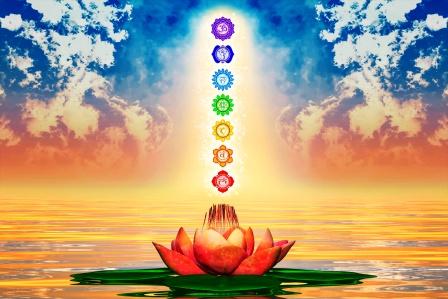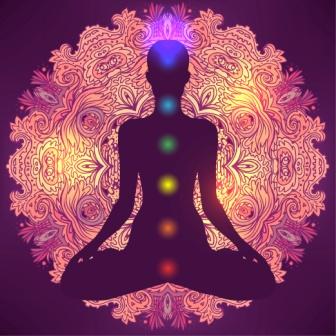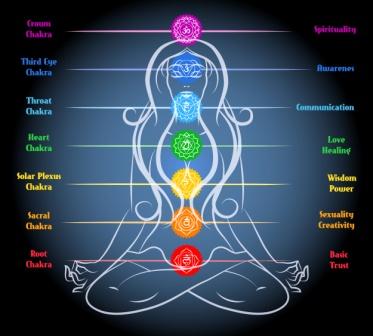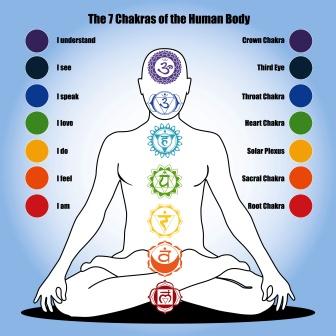Chakra – Kundalini: Introduction, Meaning, Types, Location, Ayurveda View
Article by Dr Raghuram Y.S. MD (Ay) & Dr Manasa B.A.M.S
Chakra in Sanskrit means Wheel. Wheel has been an essential part and witness of human evolution through ages. We cannot imagine our progression and evolution if the wheel is removed from the equation.
Would you believe if I say that the human life and all activities of the body and mind are connected to some unseen wheels which are out of the territory of our perception?
Life is dependent on the energy which we derive from various things. Life is energy by itself. All the physical and mental activities of the body are run by energy.

Table of Contents
Chakra, Location
This energy is derived from imaginary wheels which are the transmitters of energy. These wheels of energy which are in continuous spinning in our aura, parallel to our spine, right from the bottom of our tailbone, to a few inches above the crown of our head are called Chakras.
Chakras, their location, how they work:
The outer and inner energies and communication between them – There are a lot of energy fields in and around us. There is an in-built energy within our system which keeps the body activities and dynamics going in a smooth way, uninterrupted, 24 X 7.
Similarly there is so much energy outside our body, in the outer, larger world. The vital energy field which operates us from within the physical body is connected to the energy fields outside of us. These energies communicate with each other.

The energy can be correlated to a Sanskrit term Prana.
Prana or Life Energy keep entering our body and exiting in a cyclical process. This is how our interior is connected to the exterior world.
We are a part of the big universe. Our body and soul is a smaller representative of the bigger nature outside us. In short, every human is a microcosm, part and representative of the macrocosm. Just like that the energy operating us from within is a part and representative of the greater energy outside us. Our inner energy needed for day-to-day activities is derived and nurtured from the outer energy.
Thus, the Prana or life force within us is a small representative of Prana or life force outside us, of the external world. The Macro-Prana which envelopes the whole world is the source of life energy for millions of micro-pranas located in the physical beings of human, animals, plants and all life.

We all exchange the energy needed for life processes to carry on from this big body of life energy existing outside us. The outer source is inexhaustible and keeps dispensing the life energy selflessly to all the other living beings and makes the life possible on Earth.
Human Body, the portal of positive and negative energies –
While we derive Prana from the external source, we also form the portals of entry of positive and negative energies. When there are quite a lot of people around us, being positive, speaking and thinking positive, the territory around us becomes positive and productive.
It creates positive vibes and positive energy. These positive energy fields around us create and supply us with positive energy. Similarly, when there are lot of people thinking negative and ill around us, the territory around us becomes negative. It creates negative vibes and negative energy.
So, for the different energies to influx and out-flux from our body frame, there need to be some transmitters. Chakras are these unseen energy storage and transmitting centers located in front of our back bone.
Number of Chakras
How many Chakras, six or seven?
Chakras are wondrous wheels of light and color. They have have color and emit light. This color and light form our aura. The wheels comprising of chakras keep shimmering, turning and vibrating, feeding and reflecting our subtle life energies.
Chakras are map of consciousness which help us to discover more about our individual and collective purpose. Knowledge of Chakras and methods on working and balancing them helps us to heal our lives and fulfill true potential, while helping to balance our energies and trimming our physical, mental and emotional health.
Classical Chakras are six in number. They are called Shad Chakras.
Shad means six,
Chakras means wheels.
These chakras are placed at regular intervals, one above the other, each chakra interspersed with some space, in front of our spine.
There is also a 7th Chakra. It is placed above the line of the body and is placed right on top of the crown of our head, a few inches over the crown. This Chakra too communicates with 6 other Chakras which are parallel to the spine.
Each of these Chakras traps the energy from the outer source (Macro-Prana or Macro-Energy) and store them. Therefore these Chakras are the power houses or store houses of energy. They transfer or transmit the energy into our body.
Depending on their spinning capabilities, dimension and construction, each Chakra is different in shape and size and spin with different frequencies. Similarly they transmit energy also in different frequencies. These Chakras are connected to each other and they influence one another.
Aura and Chakras
The energy field around every human being is called Aura. Aura is clairvoyantly perceived in full color or as vague light. Aura stretches 4-6 inches (10-15 cm out from the physical body. Some of the basic aura colors don’t change. Other colors change according to our mood or state of health. Therefore colors are indicators of our body-mind-mood health. The aura or energy field or Prana field doesn’t exist after death.
Much of the color and energy of our auric field is supplied by Chakras. These chakras govern the energy field of our aura. Chakras are wheels of light and color inter-penetrating with (affecting and affected by) the physical body.
The knowledge of Shat Chakras is based on the relationship of consciousness, mind and soul with different Nadi Kendras (nerve centers) present in the Meru Danda (vertebral column).
Chakras are also considered as ‘Body’s Subtle Glands’ as they carry links to specific parts of physical glands or glandular systems.
Some interpreters correlate these Chakras with certain nerve plexus present in, near the spinal cord. Each of these six chakras is stated to have originated from Meru Danda i.e. Vertebral or Spinal column (backbone).
Life, Energy and Chakras
Life can be defined in terms of the energy provided by the energy wheels called Chakras. The universal life force circulates through us and brings us the experience of life.
Therefore, Chakras represent distinct frequencies within the universe. The chakras interact with the electromagnetic energy field and transform this into the energy. It later transmits this energy into our body and sustains our lives.
The universal energy is believed to flow from the earth, up into the lower chakras located at the bottom of our spine, ascending upwards to the upper chakras. This movement of energy is not linear but is cyclic, it runs both ways.
Chakras determine your use of energy i.e. how much energy you receive and how much you use it. They are the batteries for the various levels of your life energy. They receive, store and express energy by interacting with universal life force. The freedom with which energy can flow back and forth between you and the universe is in direct correlation to the total health and well-being you experience.
Any blocks or restrictions to either reception or expression of this life energy will result in a malfunction of the organism as a whole. This will be expressed in the form of disease, discomfort, lack of energy, fear or emotional imbalance.
Chakras are floors of the ‘spine’ elevator or ‘spine’ building
Each of the Chakras offers a different perspective and dimension on life or any given situation.
If the spine is considered as an elevator or lift, the chakras represent various floors from which we experience life. The experience of life and energy at each floor or chakra is different. As we ascend from one floor of consciousness to the other, our perspective expands and we see life with different experience and in different perspective.
Similarly if the spine is considered as a building, the chakras can be imagined as 7 floors of that building. When you are on the ground floor or the lower most chakra and look out of the window of that floor (look at life), the view is significantly different from the experience obtained from the windows of the other floors.
With successive elevation over each floor, one’s view becomes more expansive. The idea is to have clean windows at each level, at each floor so that the view can be the clearest. Beliefs and pre-occupied ideas can cloud the windows and make our perspective of looking at life unclear.

We should be ready to challenge the existing beliefs to clean them and we should be open minded enough to accept life and experiences as they appear from each floor and live according to the corresponding experiences. We and our perspective of looking at life and the experience we gain goes on maturing as we ascend upwards, on to the top floors or successively upper chakras.
Clear perception is the goal, clear and clean windows, not clouded by culturally conditioned beliefs.
Traditional Chakras
The traditional Chakras are 7 in number and are named from below upwards, according to the position in which they are placed (one above the other) in the line with spine.
1. Muladhara (Mooladhara) Chakra
Also called Root Chakra, Red Area of the aura
Located at Guda sthanam (anal region) – Root of the spine, below the most bottom part or tip of the back bone
Anatomical equivalent:
Spinal portion of Lumbar Plexus, Outer portion of Pelvic Plexus
Pelvic plexus of Sympathetic nerves or Autonomous system
Read more about Muladhara Chakra
2. Swadishtana Chakra
Also called Sacral Chakra,
Orange Area of the aura
Located at Linga sthanam or Linga mulam (root of genitals or genital area)
Few inches below the navel and slightly above the pubis (root of genital organs)
Anatomical position:
Spinal portion of Lumbar plexus, outer portion of inferior mesenteric plexus
Hypogastric Plexus
Read more about Swadhishtana Chakra
3. Manipura Chakra
Solar Plexus,
Yellow Area of the aura
Located at Naabhi (navel)
Around the navel, few inches above and below the navel
Anatomical position:
Spinal portion of the sympathetic centre in lower dorsal section of spinal cord
Solar Plexus
Plexus of Coeliac axis
4. Anahata Chakra
Also called Heart Chakra or Green Area of the aura
Located on the spine, at the level of Hridaya (Heart) Chest, in the region of the heart
Anatomical composition:
Spinal portion of upper dorsal section of spinal cord, outer portion of cardiac and pulmonary plexus
Cardiac plexus (of the sympathetic)
5. Vishuddha Chakra
Also called Throat Chakra or Blue Area of the aura
Located on the spine, at the level of Kanta (Throat). In the region of throat
Anatomical composition:
Vital centers in the Medulla, Upper parasympathetic system
Pharyngeal plexus (of sympathetic)
6. Agna Chakra or Ajna Chakra
Also called Brow Chakra or Indigo Area of the aura
Located at the level of Bhru Madhya (between Eye Brows)
Between the eyebrow, in front of the center of the forehead
Optic Thalami Plexus of command
The Naso-cietiary extension of the cavernous plexus of sympathetic
7. Sahasrara Chakra (Sahasrara Padma)
Also called Crown Chakra or Violet Area of the aura
Anatomically located at center of the cranium, in between saggital and coronal sutures of the skull
The other Chakras
The modern day philosophers who have worked on the Chakras and Chakra energies have added a few chakras to the traditional list of 7 chakras. They are –
The Base Chakra – Located at the pubic bone area, at the root of the coccyx or tailbone
The Hara Chakra – Located in the auric field between the sacral and solar plexus chakras
The Unconditional Love Center or Chakra – Located within and extending the usual Anahata or Heart Chakra
The Third Eye Chakra – It is a vortex chakra, in the auric field, out from and slightly above the brow chakra or the Agna Chakra
Kundalini Shakti
Kundalini Shakti is a principle from Hindu philosophy which helps us in understanding the process of moving the energy from the lower chakras to the higher chakras. Basically Kundalini means ‘serpent power’. It is believed that Kundalini, which is an enormous energy, is located at the base of the spine and is in the form of a coiled serpent. This energy should be mobilized upwards to gain different experiences of life at different stages of growth and maturity (as the age progresses). The ultimate aim is to make it reach the Sahasrara Chakra. For this to happen, the snake should be motivated and mobilized so as to uncoil and move upwards. This uncoiling of the serpent Kundalini and mobilization of energy in the upward direction takes place due to different situations, exercises and meditations. As the Kundalini uncoils and moves up the series of upper chakras, it releases the energy stored in each chakra it comes into contact with. This method of visualization offers an image of understanding the process of awakening to the surge of energy released in the upper chakras.
Other factors related to Chakras
Aakara (Shape) – Chakras mean wheels. But each Chakra is said to be in the form of a flower with open petals. They are called Dala. Each Chakra has distinct number of Dalas.
Beeja Aksharas – Each Chakra is associated with certain alphabets called Beeja Aksharas, which need to be meditated to bring about balance of the chakras. Example, Vaa, Sa, Sha, Sa are the Beeja Aksharas of Muladhara Chakra.
Adhisthita Shakti / Chakra Devata / Adhipati – Each Chakra has a deity. It is said that that particular chakra is governed and ruled by that particular god or goddess.
Chakra Adhishtita Pashu – Each Chakra is governed by an animal or bird.
Chakra Adhishtita Mahabhuta – Each Chakra is predominant in one Mahabhuta or element of nature. Example, Mooladhara Chakra is predominant in Bhumi Tatva (Earth element), Swadishtana Chakra is predominant in Aaap Tatva (Water element) etc
Balancing the Chakras
Imbalances of chakras can lead to imbalance of energies in the body at various levels of chakras. This will lead to many physical and mental disorders. One or more of the chakras can be disturbed or imbalanced at a time or the balance of one chakra can cause imbalance of other chakras too.
Balancing of the Chakras is a combination of various methods including visualization techniques, breathing techniques, chanting, quietening and stimulating fragrances, use of essential oils, exercising and meditating over the chakras, color, sound and light therapy using the colors and sounds which heal the chakras and bring about their balance etc.
Ayurveda and Chakras
The concept of Chakras has not been explained or mentioned anywhere in Ayurveda. These Chakras are explained in Yoga literature alone without any bearing on either anatomical or physiological grounds. But many aspects and concepts of Chakras have a relation to the Ayurvedic concepts. When Chakra healing has been applied after diagnosing the diseases in Ayurvedic way, good results have been seen. The blend of Ayurvedic medicine, treatments, diet changes, meditation, Yoga, meditation and Chakra Healing techniques and methods when combined in effective way, have helped in comprehensive healing of many psycho-somatic disorders.
Chakra benefits, healing
Benefits of Chakras and Chakra Healing / Chakra Balancing
Chakra balancing and healing helps in treating many diseases related to body and mind. Effective blending of disease modifying medicines and dietetic and lifestyle changes is essential. Chakra healing can thus help as an individual therapy and also as combined therapy.
Chakra healing and balancing helps in creating energy in the body
Chakra balancing helps in nullifying the negative energies and building up positive energies in the body and mind
Chakra balancing helps in keeping us strong, focused, oriented, healthy and immune
Chakra balancing helps in balancing the glandular functions and hormone imbalances which are main causes for many diseases
Chakra healing helps in solving the key issues related to chakra imbalances, like survival and security issues related with Muladhara Chakra, sex and pleasure issues related to Swadishtana chakra, power related issues of Manipura chakra etc
Understanding Chakras will help you in discovering your better self
Understanding the chakras is one of the most effective means for accessing the various levels of unconsciousness available to you. It is a simple system to comprehend yet it is profound, as a guide to the inner world.
The chakra model gives you a way of identifying the type of energy you are experiencing: survival, pleasure / sexuality, power, love, creativity, intuition, and spirituality. Each of these seven levels of energy are animated by the seven chakras.
Just Before Finishing
The knowledge of Chakras, chakra balancing and chakra healing are unconventional yet comprehensive ways of healing the body and mind and getting rid of many diseases. Meditating and working on the Chakras on daily basis helps in living a healthy, immune and disease free life. I have covered the introduction of Chakras in this article.
Click to Consult Dr Raghuram Y.S. MD (Ayu)
Chakra Activation
How to activate the Chakras with Yogasana and Pranayama?
Chakras are the energy centers situated along the line of back bone (vertebrae). Activating these Chakras means, attaining salvation or reaching the final goal of meditation. It cannot be just done with Asanas and Pranayama. For it to happen, one has to go through the 8 stages of Yoga
1. Yama – Nonviolence, being truthful all the time, not stealing (mentally and physically), abstinence from sex (mentally and physically), abstinence from geed.
2. Niyamas – Internal and external purity, happiness, purification, self-observation and devotion to God.
3. Āsana – Yogasanas
4. Prānāyāma – Controlling the mind by controlling breath
5. Pratyāhāra – withdrawal of the senses or withdrawal of mind from the senses.
6. Dhāraṇā – an art of focusing the mind over an object or subject so as to inculcate concentration.
7. Dhyāna – Deep meditation
8. Samādhi -> The enlightening of all Chakras happens here.
This is the ultimate goal that all Yogis seek. This is the ultimate goal that every spiritual Sadhaka strives for. This is the goal that may take several births and deaths to achieve.
The path is often referred to as a double-edged sword. Winning the world is easy, but winning the mind is hard. If Kama is won over, ego may hurt us, if that is taken care, anger may harm us. There are thorns on the path everywhere.
If someone is marketing some gimmick massages, perfumed essential oils, incense sticks or short-term meditation course to open Chakras up, it is most likely a scam.
It is not a linear path. Many Yogis climb a few steps up, then fall a few steps down and again climb up and so on… Sometimes failure in one stage may lead to rolling back several steps or starting all over again!
It is not for everyone. It is the path for the courageous! it is the path for the truthful…! it is the path for the brave!
Let us all make some efforts in this direction of truth-seeking. We may or may not succeed in this life but the win is certain.
Read related: Ashtanga Yoga – Introduction, Steps










2 comments
DR PRADNYA
how do u establish the reference of the above material in ayurveda- samhita.kindy enlighten.
mbeadmini01
Please quote your reference for verification.